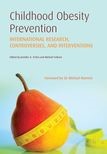 Childhood Obesity Prevention: International Research, Controversies and Interventions
Childhood Obesity Prevention: International Research, Controversies and Interventions
Contents
-
-
-
-
-
Chapter summary Chapter summary
-
Introduction Introduction
-
Reference data sets Reference data sets
-
Selection of cut-off values Selection of cut-off values
-
Terminology Terminology
-
Changes in terminology Changes in terminology
-
Barriers to consensus Barriers to consensus
-
Uses of these classifications Uses of these classifications
-
-
Conclusions Conclusions
-
References References
-
-
-
-
-
-
-
-
-
-
-
-
-
-
1 High body mass index, overweight, and obesity in children: Definitions, terminology, and interpretation
Get access-
Published:September 2010
Cite
Abstract
Studies in a variety of countries have shown increases in the prevalence of overweight and obesity among children in recent years. These increases have given rise to concern about children's health and well-being. The terminology used in these studies varies considerably. However, whatever the terminology used, such studies are generally based on weight (expressed as body mass index (BMI), a measure of weight for height, calculated as weight in kilograms divided by the square of height in meters) and not on body fatness per se. There are many different BMI references that can be used to define childhood overweight or obesity for population surveillance purposes using a variety of BMI cut-points. BMI is a screening tool, not a diagnostic tool. Children with a BMI over these cut-points do not necessarily have clinical complications or health risks related to over-fatness. More in-depth assessment of individual children is required to ascertain health status. The definitions based on BMI generally used are working definitions that are valuable for general public health surveillance, screening, and similar purposes. Terminology and measures used in studies of weight and adiposity in children and in adults is a complex area. Considerable confusion arises from the disparate uses of the descriptive terms ‘overweight’ and ‘obesity’ in children. Different reports may use the same term but define it quite differently. This chapter examines some of the definitions and terminology in use today and some of the underlying issues in arriving at consistent and coherent definitions.
Sign in
Personal account
- Sign in with email/username & password
- Get email alerts
- Save searches
- Purchase content
- Activate your purchase/trial code
- Add your ORCID iD
Purchase
Our books are available by subscription or purchase to libraries and institutions.
Purchasing information| Month: | Total Views: |
|---|---|
| October 2022 | 3 |
| November 2022 | 2 |
| December 2022 | 2 |
| January 2023 | 3 |
| February 2023 | 6 |
| March 2023 | 5 |
| April 2023 | 4 |
| May 2023 | 1 |
| June 2023 | 2 |
| July 2023 | 29 |
| August 2023 | 6 |
| September 2023 | 5 |
| October 2023 | 2 |
| November 2023 | 2 |
| December 2023 | 4 |
| January 2024 | 1 |
| February 2024 | 3 |
| April 2024 | 2 |
| May 2024 | 4 |
| June 2024 | 4 |
| July 2024 | 29 |
| August 2024 | 1 |
| October 2024 | 1 |
| November 2024 | 2 |
| December 2024 | 1 |
| February 2025 | 1 |
Get help with access
Institutional access
Access to content on Oxford Academic is often provided through institutional subscriptions and purchases. If you are a member of an institution with an active account, you may be able to access content in one of the following ways:
IP based access
Typically, access is provided across an institutional network to a range of IP addresses. This authentication occurs automatically, and it is not possible to sign out of an IP authenticated account.
Sign in through your institution
Choose this option to get remote access when outside your institution. Shibboleth/Open Athens technology is used to provide single sign-on between your institution’s website and Oxford Academic.
If your institution is not listed or you cannot sign in to your institution’s website, please contact your librarian or administrator.
Sign in with a library card
Enter your library card number to sign in. If you cannot sign in, please contact your librarian.
Society Members
Society member access to a journal is achieved in one of the following ways:
Sign in through society site
Many societies offer single sign-on between the society website and Oxford Academic. If you see ‘Sign in through society site’ in the sign in pane within a journal:
If you do not have a society account or have forgotten your username or password, please contact your society.
Sign in using a personal account
Some societies use Oxford Academic personal accounts to provide access to their members. See below.
Personal account
A personal account can be used to get email alerts, save searches, purchase content, and activate subscriptions.
Some societies use Oxford Academic personal accounts to provide access to their members.
Viewing your signed in accounts
Click the account icon in the top right to:
Signed in but can't access content
Oxford Academic is home to a wide variety of products. The institutional subscription may not cover the content that you are trying to access. If you believe you should have access to that content, please contact your librarian.
Institutional account management
For librarians and administrators, your personal account also provides access to institutional account management. Here you will find options to view and activate subscriptions, manage institutional settings and access options, access usage statistics, and more.